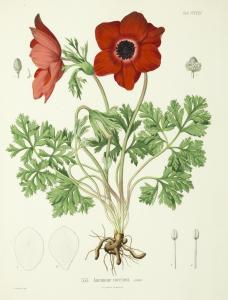Icones ad floram Europae novo fundamento instaurandam spectantes.
Eur 15,000 / USD 17,200
The price shown on each item does not include V.A.T (Value Added Tax). As a result of the recent EU legislation we are required to charge our EU customers the percentage of V.A.T. charged by the customer’s country of residence, unless they possess a V.A.T. registration number. Postage Additional.
Paris, Savy, 1866-1903. 3 volumes. Folio (400 x 305mm). With 501 finely hand-coloured engraved plates. Contemporary uniform half calf, spines in 5 compartments with gilt lettering.
The drawings? are also admirable, and from a botanical point of view beyond praise
This is one of the rarest and most beautifully illustrated and detailed botanical works. The edition must have been very small and no fully coloured copy has been offered for sale since many decades. The famous de Belder collection had a complete copy but only the first 280 plates coloured. We sold a copy of the first 2 vols in 1980. The first 2 volumes are by Claude Thomas Alexis Jordan and Jules Fourreau. The publication was interrupted by the death of Fourreau on Dec. 1870 at the battle of Nuits during the Franco-German war. Publication was not resumed until 1903 by Camille A. Jordan who published the final third volume. The 3 volumes were published as 100 fascicles over 37 years. Claude Thomas Alexis Jordan (1814-1897) was a French botanist and according to Stafleu 'whose extremely narrow species concept led to 'jordanism' and Jordan-species (jordanons) vs. Linnaean species'.
"The drawings? are also admirable, and from a botanical point of view beyond praise: ? Jordan, Alexis and Fourreau, Jules, 'Icones ad floram Europae?, illustrative of 606 microspecies (jordanons) for the most part distinguished only by minute and subtle characters and thus needing scrupulous accuracy for their portrayal"(Blunt & Stearn p. 269). For his research Alexis Jordan had a huge private experimental garden that he gradually increased to 12,000 square meters with 400 flower beds containing approximately 50,000-60.000 plants. He likewise created one of the largest herbariums known to exist. The exquisitely hand-coloured engraved plates are by C. Delorme, J. Fourreau, P. Gallaud and A Mignot. An attractive uniformly bound copy in mint condition.
Stafleu & Cowan 3416; Grat Flower Books 61; Nissen BBI, 1008.






























